If you’ve taken a drive north from Nanaimo, somewhere around Parksville you’ve probably looked left out your window towards the distant Mt Arrowsmith and the Beaufort Mountains stretching north, separating the Alberni Valley from Vancouver Island’s east coast. You may have also noticed a much closer, much smaller bump not far from the highway – I wouldn’t blame you if you can’t remember seeing Little Mountain – compared to the much more majestic distant mountain peaks it doesn’t look particularly memorable. The views from the top of this Vancouver Island hill, once the site of a forestry lookout, are another story.
Hikers near the top of Little Mountain are greeted with sweeping views including Nanaimo’s iconic Mt Benson to the south, Mt Moriarty, Mt Arrowsmith, Mt Wesley, and the many peaks of the Beaufort Range. In the distance Denman and Hornby Islands are visible to the north, with a tiny blue ribbon of sea separating them from Vancouver Island. The wide-open western views from Little Mountain make it a perfect sunset location, and the road winding up to the top of the hill means it’s popular among non-hikers as well. Sadly this has been to the site’s detriment, as it’s a popular dumping ground. Local hicks drive up furniture, appliances, and all sorts of garbage and toss it off the cliffs onto the trail below for fun. Looking down from the top of the cliffs is a horrible view of a garbage dump. Fortunately the trail directly below the cliffs is not the trail I took to hike up Little Mountain.
Continue reading this blog post for everything you need to know to experience the Little Mountain hike near Nanaimo for yourself, including distance, elevation gain, how to get there, the best time to visit, and lots of photos of my experience.
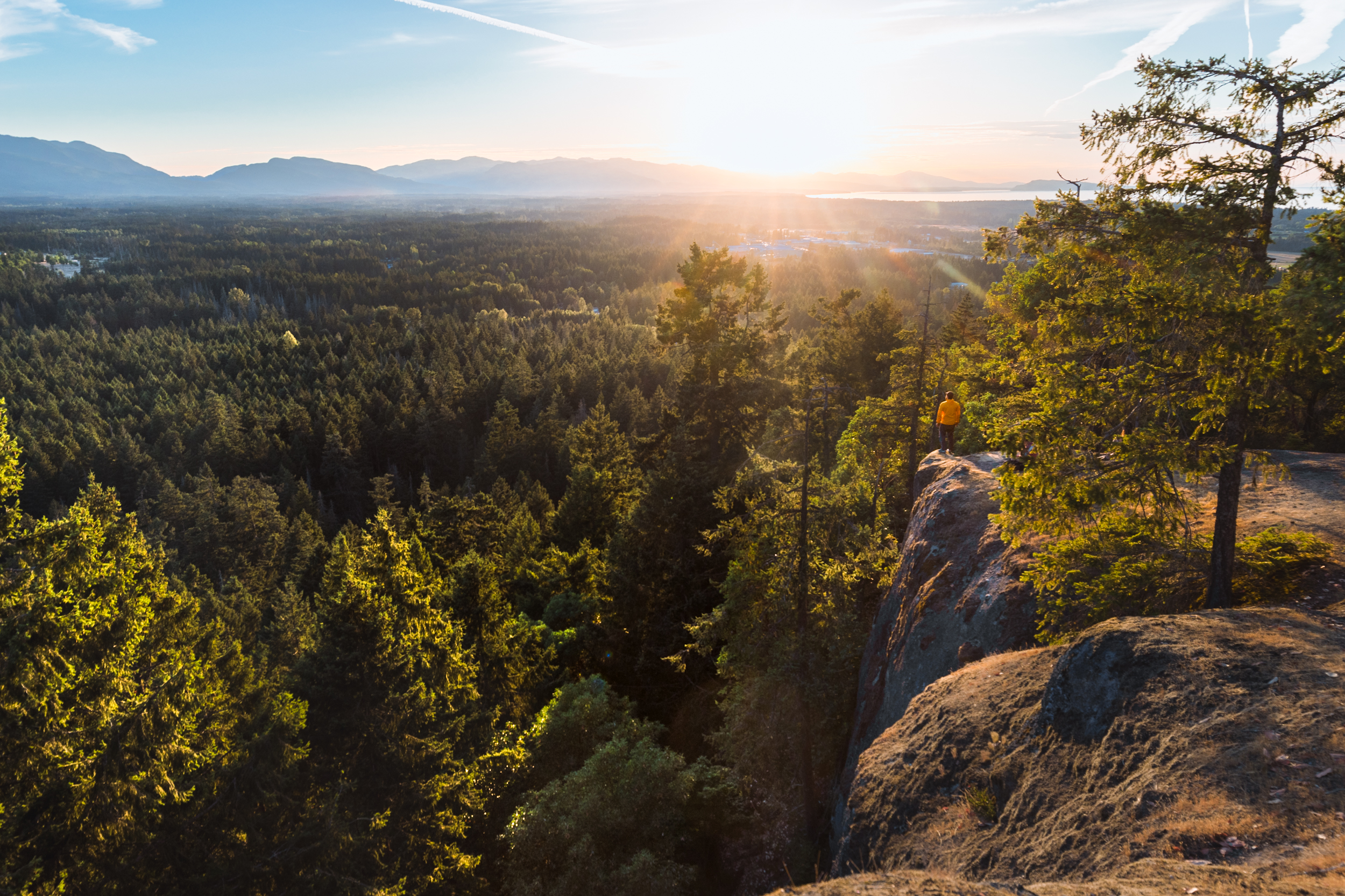
When hiking it’s important to avoid harmful practices such as disturbing plants or rock-stacking, or removing any natural object from flowers to rocks, as it’s important to leave the environment as natural as possible for the animals and for fellow hikers to enjoy in perpetuity. As many flowers as there are, there are few enough that if we all took one, then there wouldn’t be any left. Take only photos, leave only footprints.
If you haven’t heard of Leave No Trace principles, they’re also really essential to read up on before heading anywhere into the outdoors in general. Following these important principles basically means doing your best to leave beautiful places like Little Mountain as good (if not better) than you found them, both for their preservation and for the enjoyment of other visitors.
Little Mountain Round Trip Details
Distance: 5.6 KM / 3.5 MI
Elevation Gain: 167 M / 515 FT
Hiking Time: 2 Hrs
Hiking & Safety Tips
- Prepare for the possibility of wildlife encounters. There are almost no grizzly bears on Vancouver Island, but black bears are still common. Bear bells are proven to be an ineffective bear deterrent, and are even actively discouraged by Parks Canada. The best way to let bears know you’re around is simply to use your voice. Make sure to keep a respectful distance from wildlife and never feed the animals. It may seem kind but it doesn’t just kill wildlife and put people in danger, it’s also in many cases illegal.
- Research current trail conditions and make sure you are well-informed about the route before you leave, and assess if it is within your capability. Be aware of what time it gets dark and check the weather forecast. Make sure to tell someone where you’re going and when you expect to return. Every year as more and more people try hiking for the first time, the number of rescues goes up. Being prepared is the best defense.
- Pack everything you need for a successful hike, including enough water and energy-rich snacks. Remember to pack out everything you pack in though – don’t expect to find a convenient garbage can halfway up the trail. Bring appropriate layers (remember you’ll warm up once you start hiking) and sun protection. Hiking poles may be helpful but are not required. In addition to not leaving any garbage on the trail yourself, I highly recommend bringing a garbage bag and collecting any trash that you do see on the trail. You’reguaranteed to make the hike up Little Mountain a more enjoyable experience for the next person.
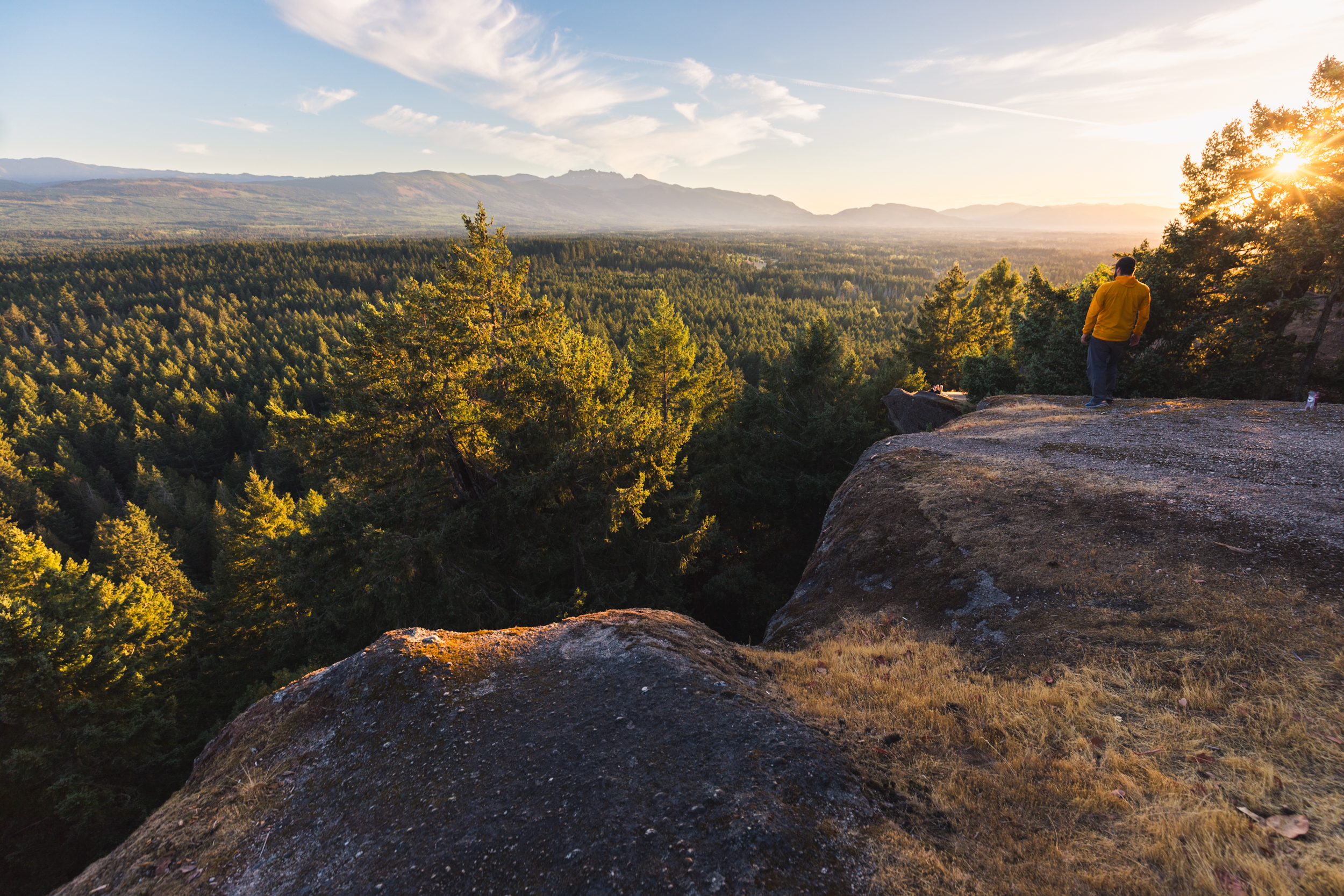
How to Get to Little Mountain Trailhead
The start of the Little Mountain hike is only about five minutes from downtown Parksville, about half an hour from Nanaimo, or 45 minutes from Port Alberni. From the Island Highway in downtown Parksville not far from Parksville Community Park, turn south onto the Alberni Highway out of town. After a couple kilometres you’ll reach the Inland Island Highway. Continue straight, passing underneath the highway and out the other side. Take your first left at the corner with the Petmania. Follow Bellevue Road for a couple minutes. When it turns sharply to the right and becomes Matterson Road pull off near the turn. The trail starts on the left.
Click here to open the exact trailhead location in Google Maps.
Hiking Little Mountain

The start of the Little Mountain Hike, right at the corner of Bellevue and Matterson Roads.
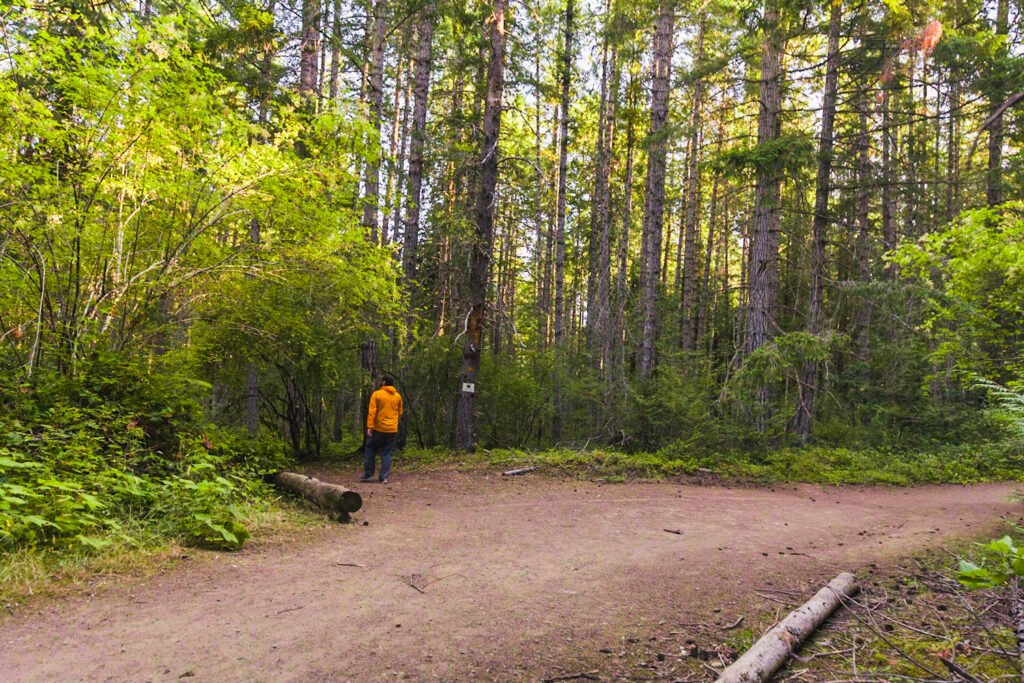
After about 300m of walking along the wide and flat trail, turn left onto a narrower trail into the trees.
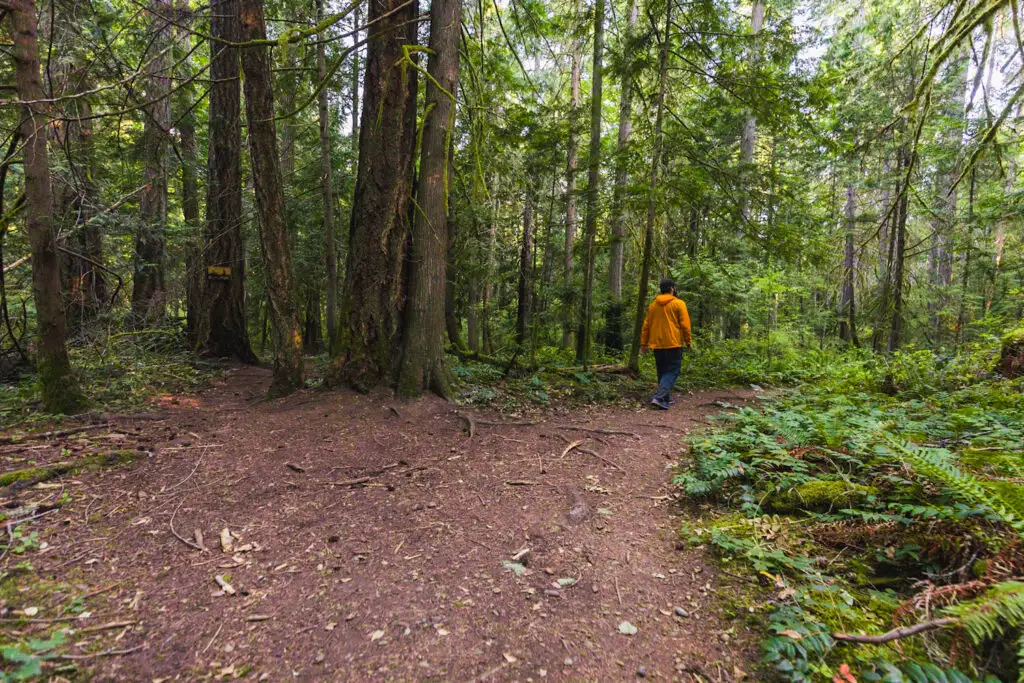
Keep relatively straight on the path, and avoid a swamp sidetrail heading off to the left here.
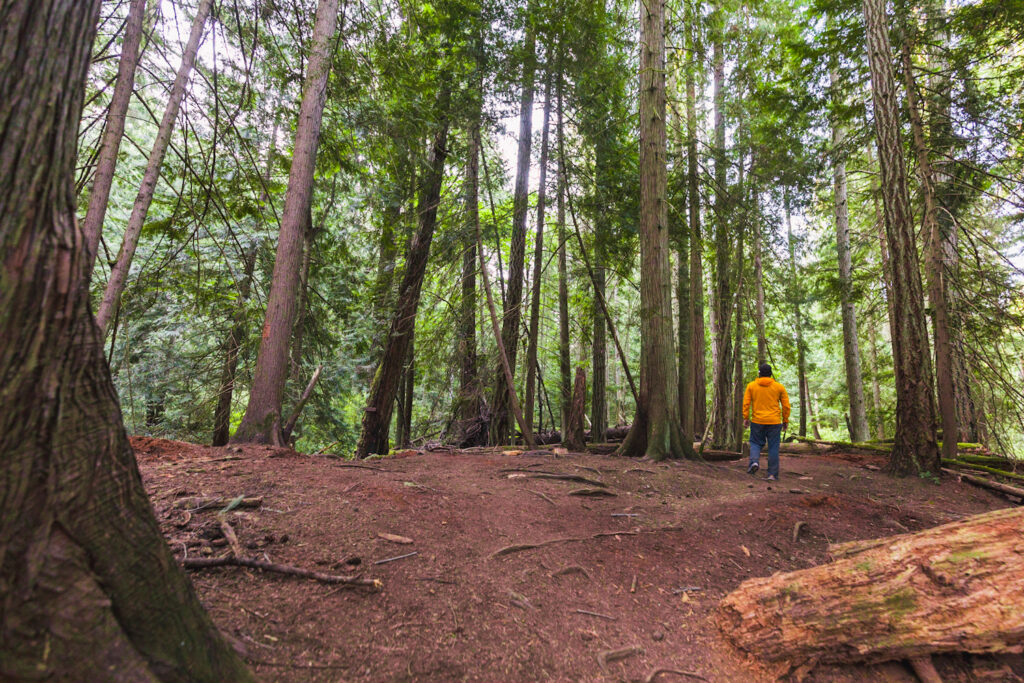
It’s hard to figure out what’s going on at this intersection because it’s turned into one giant trampled clearing. Head to the right here. If you miss the turn and continue straight you’ll immediately reach a small bridge. If you reach the bridge you’ve gone too far.
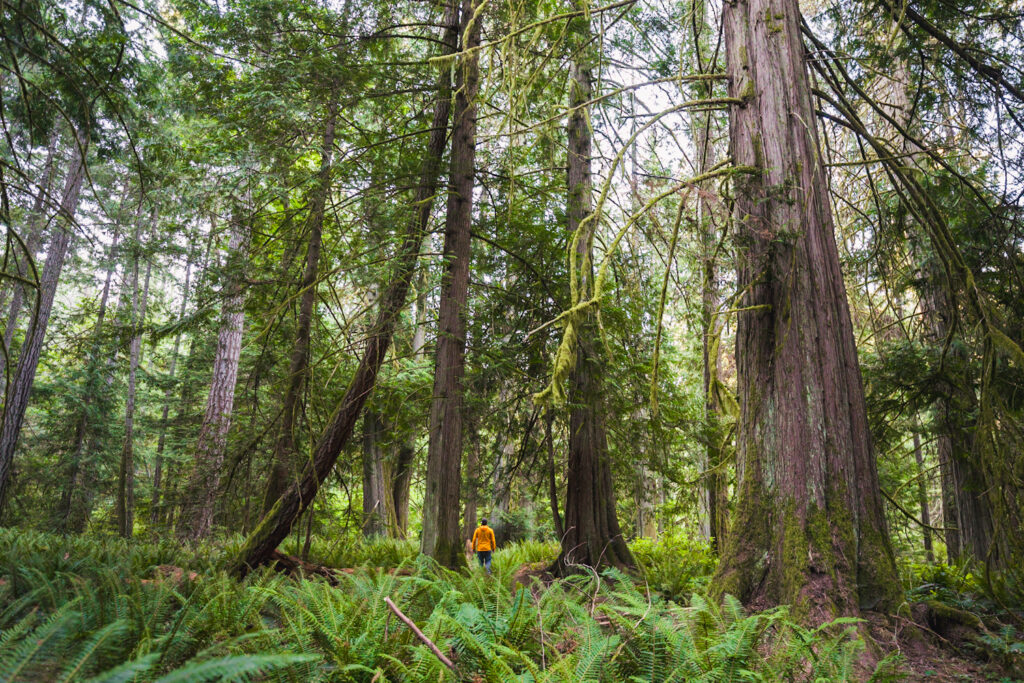
There are a few nice big old trees along the trail up Little Mountain.
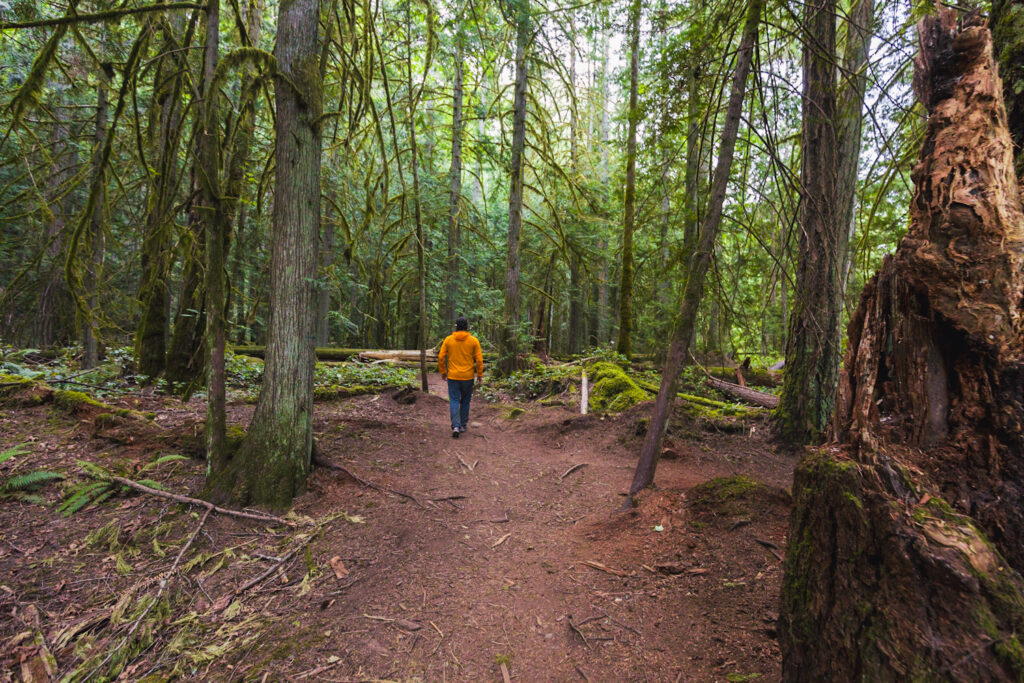
A bike trail crosses the path heading up Little Mountain. As long as you stay on the main path and head relatively straight you’re probably going the right way.
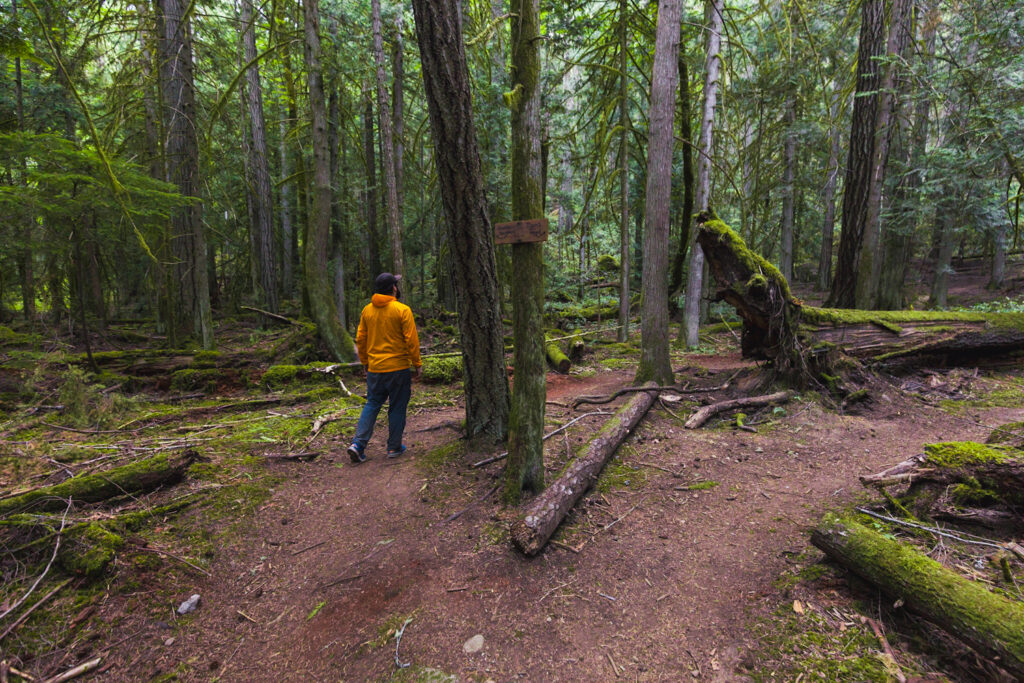
Following signs for Boulder City.
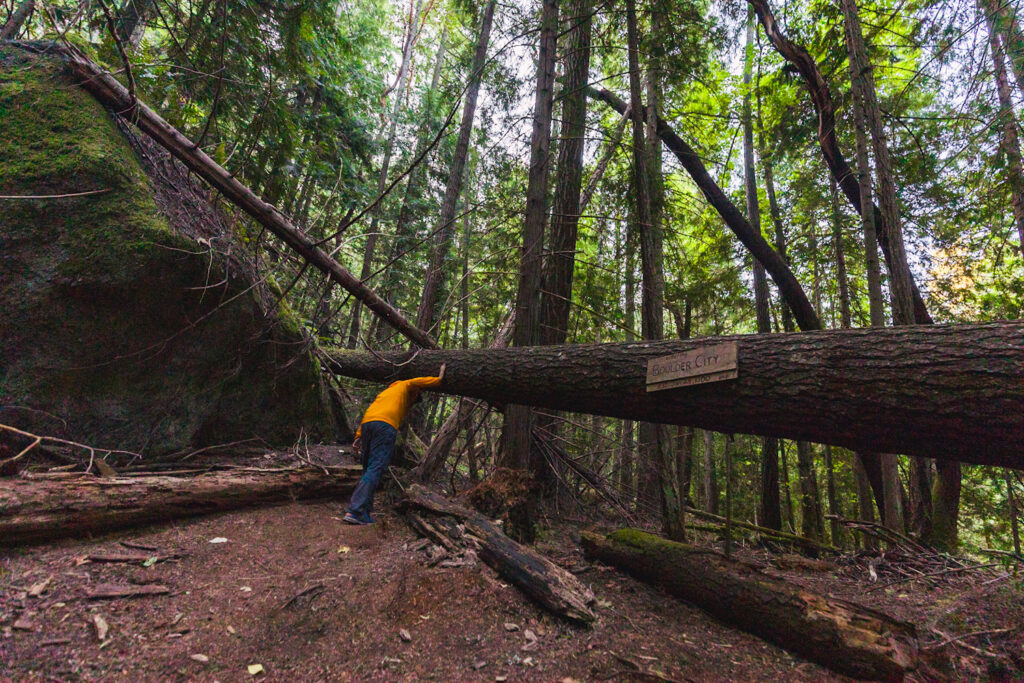
Following signs for Boulder City.
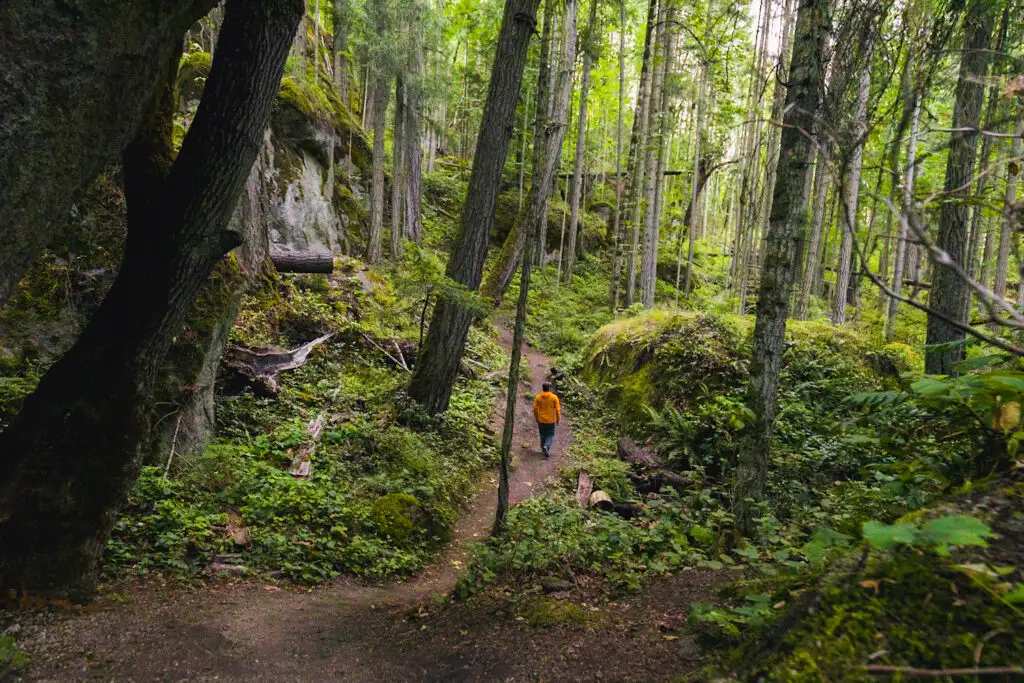
Boulder City doesn’t disappoint. Massive chunks of rock that have been cleaved off of the cliffs of Little Mountain have crashed down the hill and settled here for thousands of years.

The trail briefly divided in two but reconnected a few minutes later. The trail on the left was easier I believe.
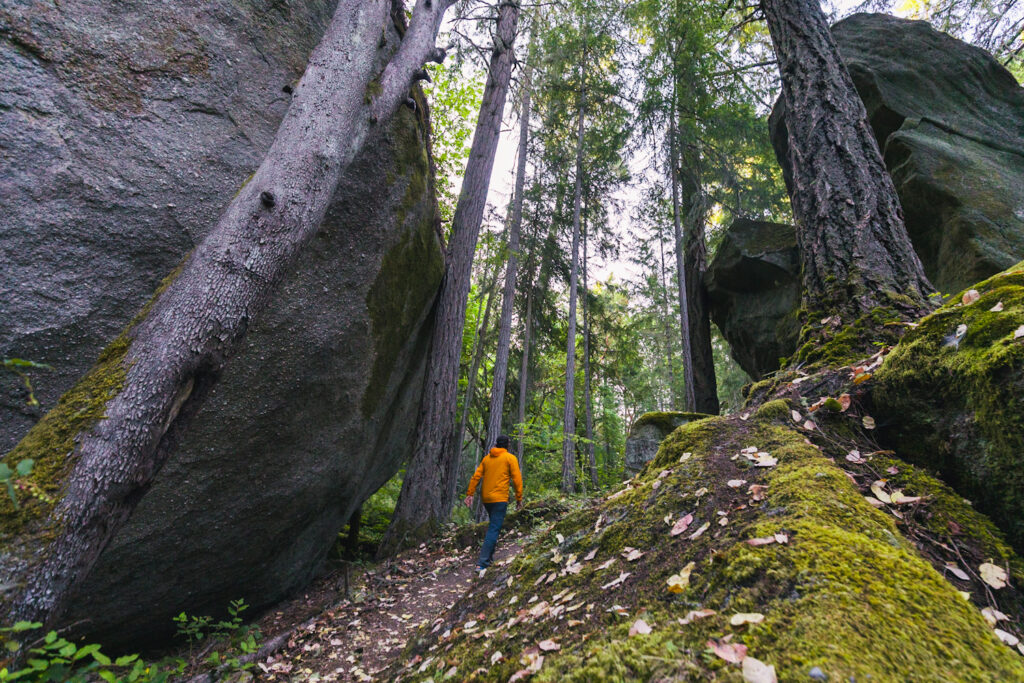
A few of the giant rocks the trail weaves between as it crosses below Little Mountain’s cliffs.
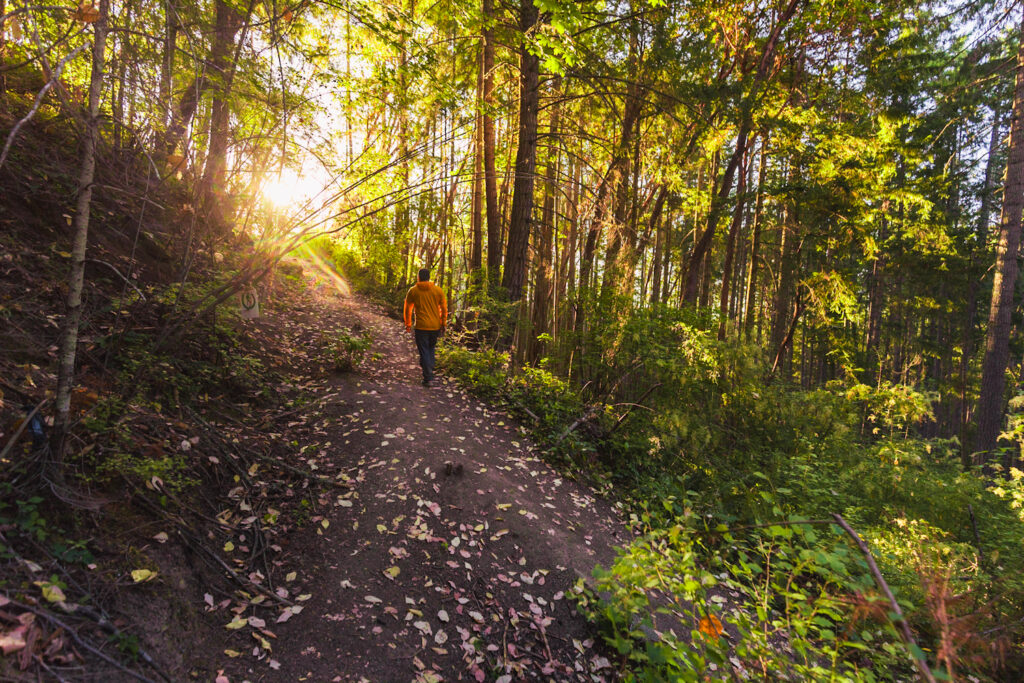
A left turn onto a path heading up out of the woods and into a cutblock on the side of Little Mountain.

There are a few ways to reach the side of the cutblock. I continued straight through the first intersection. The tree ahead makes a good landmark.
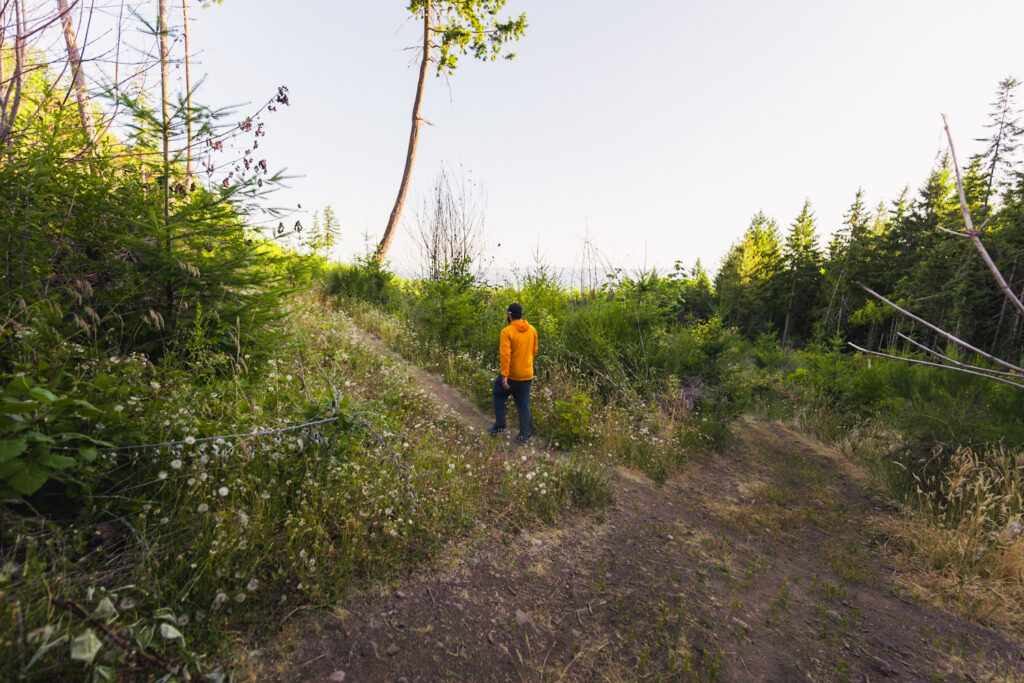
I turned left at the second intersection a moment later and followed it up along the side of the cutblock.
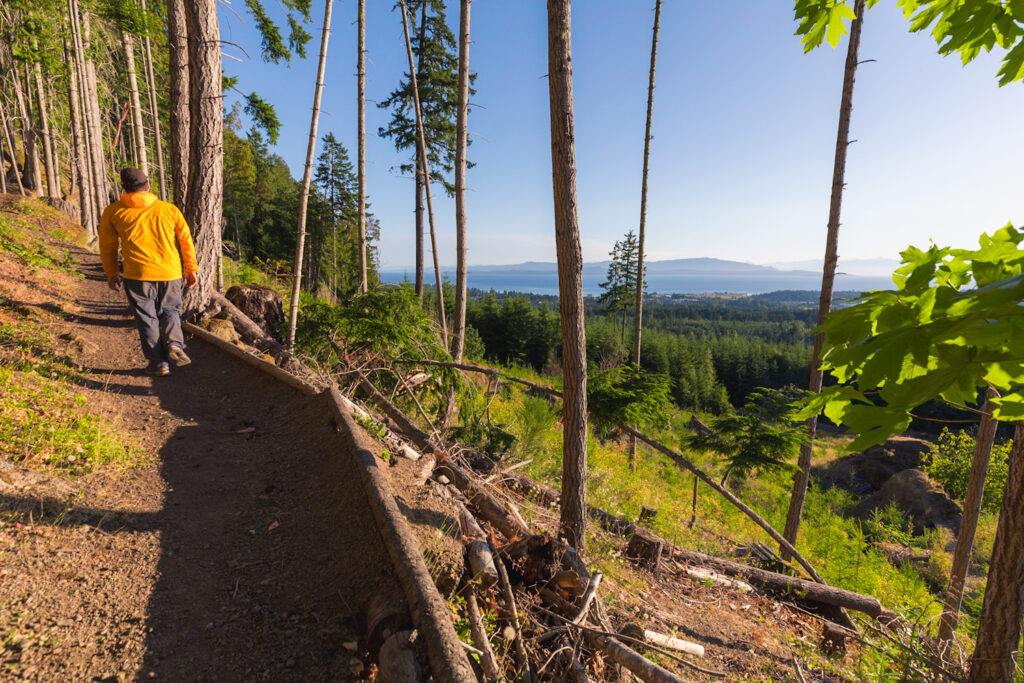
Walking alongside the cutblock. From here it’s possible to see to the east towards Lasquetti and Texada Islands as well as the mainland. From the viewpoint at the top of Little Mountain there are only views back to the west.
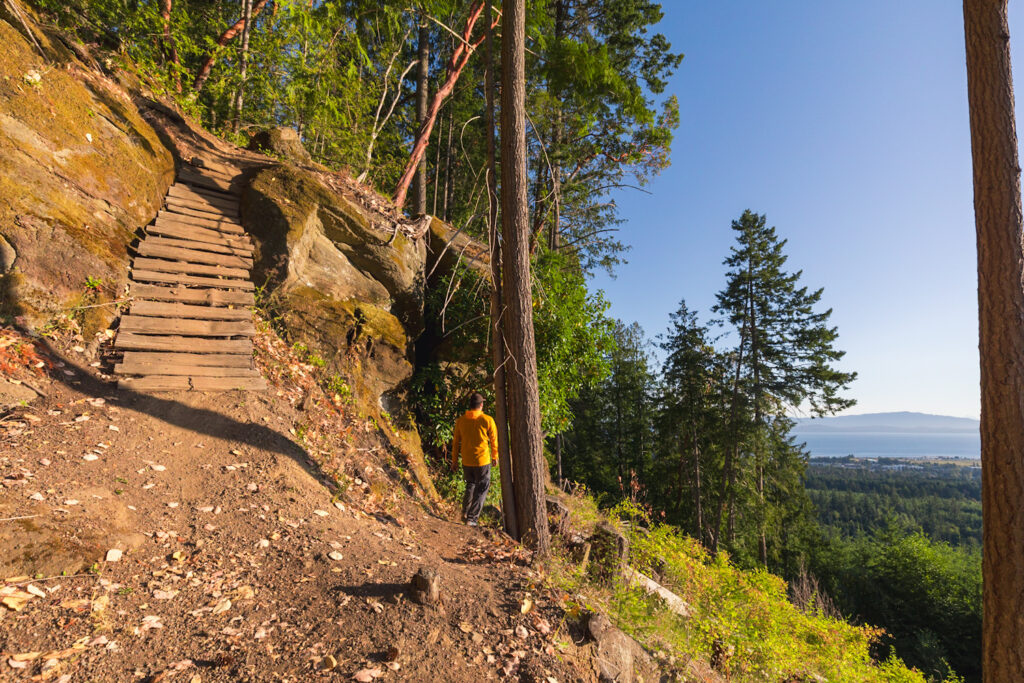
Continuing alongside the cutblock there are several downhill bike trails heading up the hill. They’re too steep to hike up though. Continue around the corner past this section for the best place to hike up.
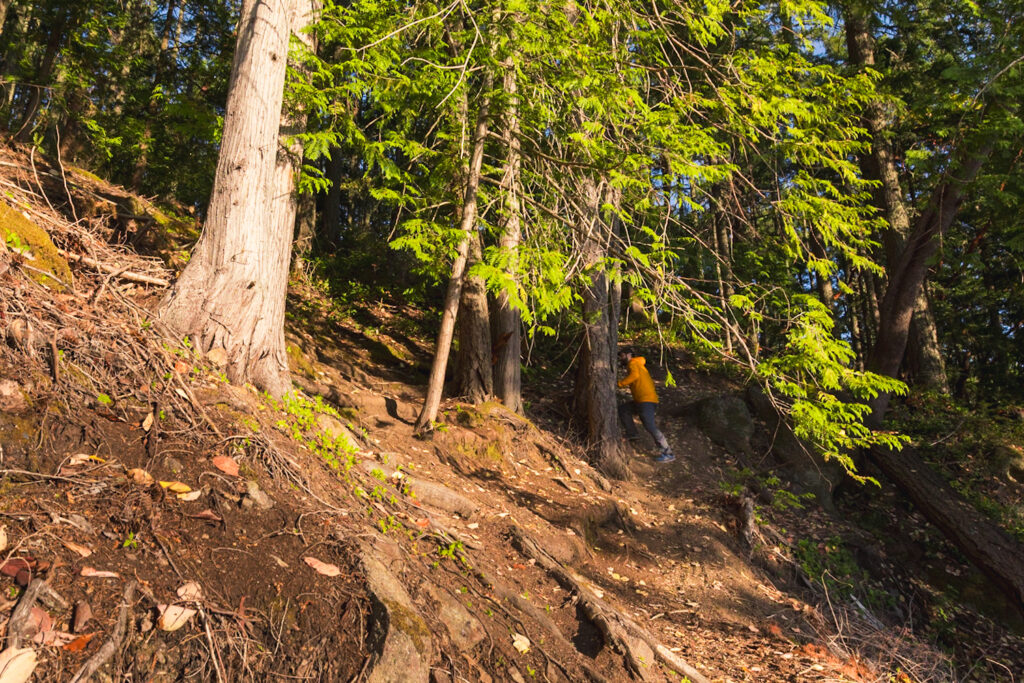
The slope here is a manageable spot to walk up to the trail. Head left to switchback above the cutblock trail.
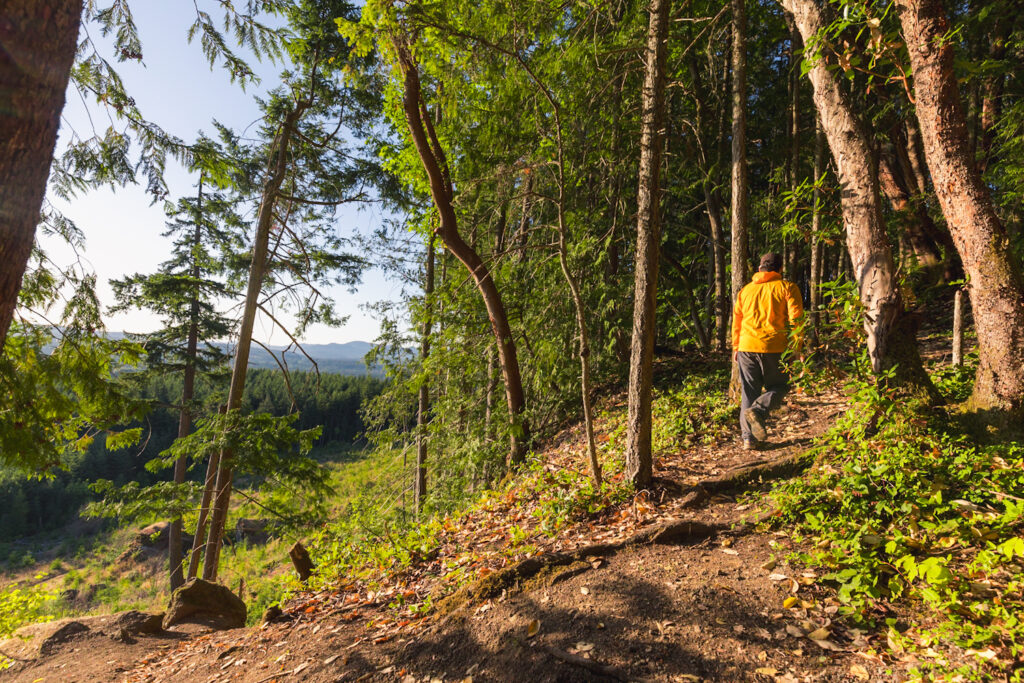
Heading back in the other direction. There are a lot of different trails, most of which head to the summit. Because of the million different intersections I haven’t photographed them all. I pretty much kept to the left to follow alongside the top of the cliffs to the top of Little Mountain. If there’s a section that the trail gets too close to the cliffs for you then just take an option on the right before reconnecting back to the left at the next intersection.
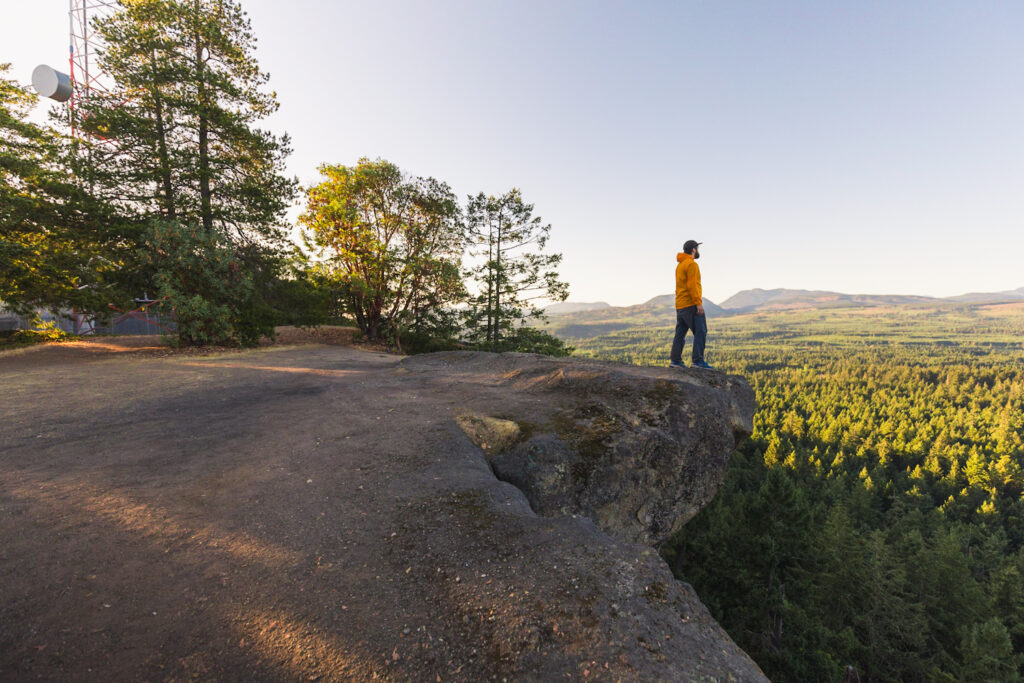
On top of Little Mountain. The recognizable FM tower in the background.
Recommended Hiking Gear



Water is a must whenever I’m hiking, especially if the sun is going to be out. My favourite water filter I’ve used is the Katadyn BeFree 0.6L, which unlike other water filters I’ve used packs up really small and lightweight. For hikes where I know there won’t be any readily available water sources along the way, I make sure to bring my own. The Hydrapak Stow 1L bottle is my go-to, for the same reason that it’s made of a soft plastic that folds up and doesn’t take up any more extra space than necessary in my pack. Finally, Aquatabs are another great option for purifying water, with one tablet being suitable for one litre of water. I previously used the Grayl water filter while travelling internationally, and though I found its hard body more convenient for day to day use and easier to drink from, it has a little too much bulk for my fast-and-light style of hiking.



The secret to all my photos of gorgeous sunset and sunrise mountaintop views? A lot of hiking in the dark. And let me speak from personal experience when I say that the last thing that you want to happen when hiking is to be caught in the dark without a headlamp. I used the Black Diamond Spot 400 for years and it worked great – until I lost it on top of a mountain somewhere. The only downside to it was having to worry about the batteries dying, though there’s also a slightly more expensive version that has a rechargeable battery. Nowadays I’m using the Petzl Actik Core, which is a bit pricier than the more budget-friendly Black Diamond, but is also brighter, more comfortable (in my opinion), and has a hybrid power system that is rechargeable but can also take AAA batteries if needed.
You won’t see me using trekking poles on shorter hikes often – but on long hikes and backpacking trips, as well as certain scrambles, they are an absolute lifesaver. I’ve invested in a high quality ultra-lightweight pair of MSR DynaLock Ascent carbon poles which, while pricey, I don’t regret one bit. If you’re not entirely sure how much use you’re going to get out of a pair of trekking poles, the best budget-friendly option would be the Trekology Trek Z 2.0. Amazon does sell a lot of cheaper Made in China-style trekking poles for cheaper, but these usually are much much heavier and not worth buying.
All the best and most long-lasting cables and power banks I’ve ever owned have been Anker. I once had a phone cable from them that lasted me over three years of daily use! That’s why I keep an Anker PowerCore Essential 20K power bank on me. Like many people I use my phone for a lot of stuff when hiking (checking in with family, using online maps, taking photos, flying my drone) so I like to be prepared for that low battery warning by having a backup power source on me just in case.



The only socks I ever buy for myself are from Darn Tough, and I almost always make sure to wear them when hiking. After years of having no problems only wearing these comfortable and rugged socks for hikes, I accidentally wore a pair of no-name socks on a hike last year and ended up with blisters on both feet. Safe to say I’m back to sticking with the Darn Tough. And the best part? They have a lifetime guarantee, meaning that if they ever wear out you can send them back for a brand new pair. For hiking footwear I go between a pair of lightweight approach shoes for quick and dirty mountain ascents or anything involving scrambling and more heavy-duty boots for longer treks. I’ve worn a couple different versions of the lightweight but super durable Arc’teryx Konseal FL 2 approach shoes for a few years now and am very impressed with the durability. I also really like the thick toecap that keeps me protected every time I stumble into a root or large rock. For longer, tougher, or muddier treks I rely on my LOWA Camino EVO GTX, which I find insanely comfortable and made of very high quality.



I wear my Ar’teryx Gamma Lightweight Pants on every single hike I go on, and on many days when I’m not hiking. After several years of abuse they are still holding together extraordinarily well, with only a few small holes from where I’ve fallen down and some slight stains from being repeatedly coated with mud. They’re lightweight, breathable, and super comfortable. For lightweight and breathable hiking tops I’m a big fan of both the Patagonia Capilene Shirt and the MEC Core Shirt. My Arc’teryx Squamish Hoody shows up in a lot of my photos. It’s super lightweight and packable, and does a great job of cutting the wind while also being pretty breathable. I also have an Arc’teryx Atom Hoody and Arc’teryx Beta LT that I pull out for cooler or wetter conditions.
I hope you enjoyed this guide to hiking Little Mountain near Nanaimo! Feel free to leave any questions in the comment section below or to contact me directly via social media.

Your google maps link isn’t even close to the actual trail! It’s not even the right city!!
Hi Jodi, sorry about that! Thanks for letting me know, and I’ve put in the correct link now.